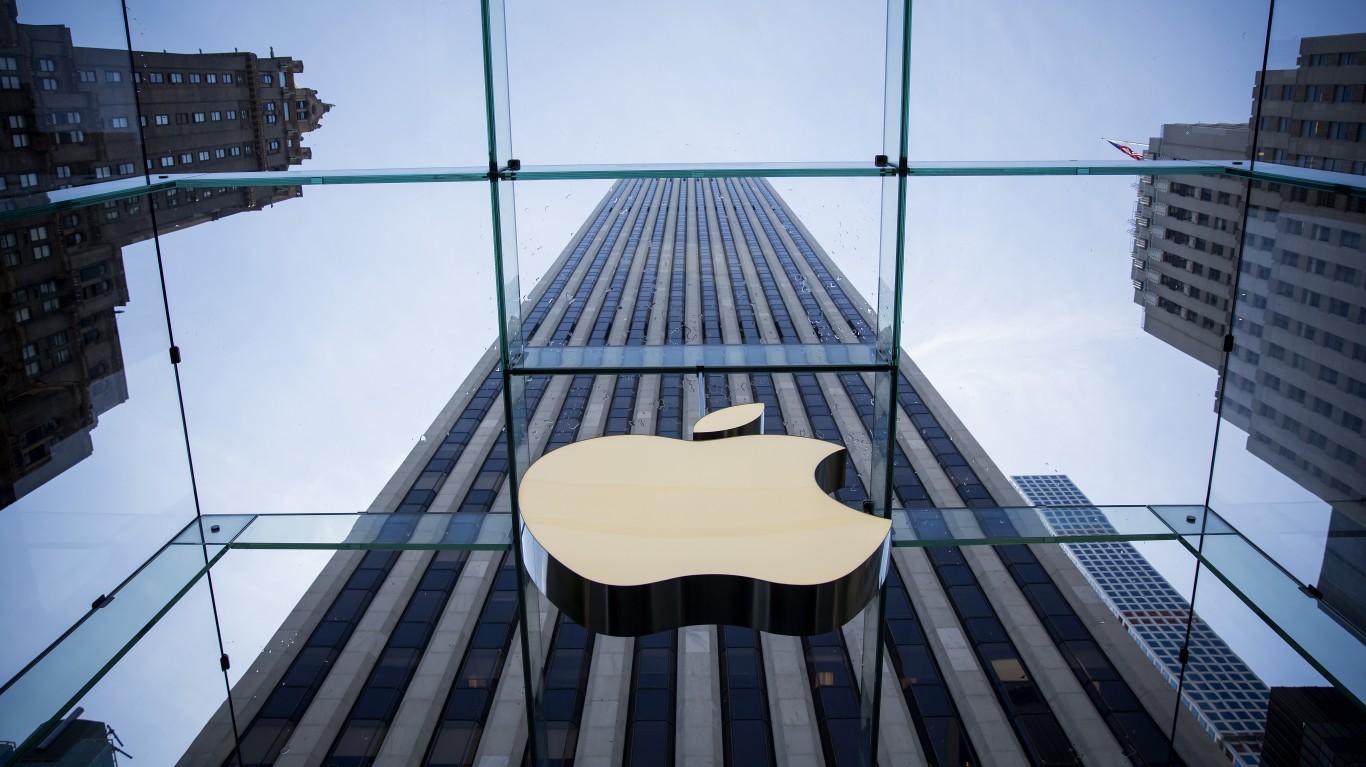
It’s hard not to be optimistic in the long term about Apple Inc. (NASDAQ: AAPL), which has consistently outperformed for years now. Even if there are near-term disruptions (which are expected), many are taking a long-term perspective on the stock. Apple’s most recent earnings report shed more light on where the company stands despite the pandemic.
Apple’s current price-to-earnings (P/E) ratio of nearly 23 is a little expensive compared to the rest of the Dow Jones industrial average, but Apple stock has earned this premium by years of outperformance. In a sense, the effect of the COVID-19 pandemic is already priced into the valuation, but this report provided more insight into how Apple is faring.
The China Problem
Apple previously said that its revenue would not meet expectations in the current quarter. The forecast was for revenue of as high as $67 billion. The company was not specific about the new figure, probably because it did not know yet.
The major immediate causes were problems with its supply chain in China and a drop in consumer activity there. However, these are only two symptoms.
Lack of supply of iPhones, many of them made in China, will be felt across the world. In the most recently reported quarter, Greater China revenue was $14 billion, out of Apple’s $92 billion total revenue. The domino effect of lower supply could undermine sales.
The iPhone is at the center of Apple’s tech ecosystem, which covers 1.5 billion devices, like iPads, MacBooks and the Apple Watch. Any slowing of iPhone sales also could affect Apple’s software and services business (including Apple TV), which it claims are the engine of its future growth.
Analysts Thoughts Going Into Earnings
As it was one of the most anticipated earnings reports of the season, analysts already had weighed in on what was to come. BofA Securities remained very positive on Apple, reiterating a Buy rating about a week ahead of the report and raising its price objective to $310 from $300. However, this call was not all blue skies:
We expect Apple to report F2Q well below consensus (not fully adjusted) and to guide well below consensus as well. Although Apple could choose to not provide any guidance, we think Apple could also provide a much wider than normal range to encapsulate the uncertainty of COVID-19. We remain confident on the long-term trajectory of the business but highlight some risks.
One of the biggest analysts came out against Apple a couple of weeks ahead of the report. Goldman Sachs downgraded the stock to a Sell rating and cut its price target to $233 from $250, as it reduced its earnings estimates for a third time since February 17.
Goldman Sachs analysts, led by Rod Hall, said they were modeling a far deeper reduction in unit demand through mid-2020, followed by a shallower recovery heading into 2021. The investment house detailed in its report:
We also assume some lingering ASP (average selling price) weakness as consumers look to economize similar to what we have seen in prior downturns. In addition to this we believe that Services growth slows substantially in 2021 and that Services as a percentage of revenue actually stagnates in that year.
Overall, Goldman Sachs expected a 36% decline in iPhone unit demand in the second quarter and a 24% decline in the first half of calendar 2020. The analysts anticipated the company’s other products would experience a similar trajectory.
Goldman Sachs further detailed:
There are multiple examples of ASPs dropping in the midst of a recession and then remaining weak well beyond the point when units recover. Price weakness could affect 5G design choices too, and limited global travel may cause the delay of the launch of this year’s updated iPhone.
Edging Out Earnings
The tech giant held its earnings call after the close on Thursday and reported $2.55 in earnings per share (EPS) and $58.3 billion in revenue. That compared with consensus estimates of $2.26 in EPS and revenue of $54.54 billion. In the fiscal second quarter of last year, Apple posted EPS of $2.46 on $58.02 billion in revenue.
One thing to note is a shift in sales in Apple’s geographic segments, namely that International sales accounted for 62% of the quarter’s revenue.
Apple’s board of directors declared a cash dividend of $0.82 cents a share of common stock. The dividend is payable on May 14, 2020, to shareholders of record as of the close of business on May 11. The board of directors also has authorized an increase of $50 billion to the existing share repurchase program.
For the quarter, the firm reported its major product categories as follows:
- iPhone pulled in revenues of $28.96 billion, a decrease of 6.7% year over year.
- Mac revenues decreased by 2.9% to $5.35 billion.
- iPad revenues decreased 10.3% to $4.37 billion.
- Services revenues increased by 16.6% to $13.35 billion.
- Other Products revenues increased by 22.5% to $6.28 billion.
Tim Cook did not supply guidance for the current quarter, noting the lack of visibility and uncertainty in the short term. The consensus estimates call for $2.07 in EPS on $51.54 billion in revenue for the quarter.
Smartphone Shipments
Research firm IDC reported a year-over-year shipment drop across the industry of 11.7% in the first quarter. That translates into shipments of 275.8 million smartphones. Since the smartphone has fundamentally replaced the laptop and tablet for hundreds of millions of people, the figure speaks volumes about the breadth of the decline of gross domestic product (GDP) across the world. Consumer spending, for example, is two-thirds of GDP.
Apple shipped 36.7 million phones, a decline of only 0.4% from the first quarter of last year. IDC analysts wrote:
This is primarily due to the continued success of its iPhone 11 series. Looking forward, the launch of the recent SE (2020) device targeting the lower-priced segment could work well for the vendor if consumers shift their buying preferences towards more budget-friendly devices in the uncertain economic climate of 2020.
Post-Earnings Analyst Calls
Many analysts on Wall Street felt quite positive about Apple after the report. There had been expectations that things could have been far worse, and without the bear market this report likely would have seen many more $400 price targets, rather than the price targets seen today. That is true even after a key analyst cut Apple to a Sell rating.
Wedbush Securities reiterated its Outperform rating and $335 price target. The firm’s Daniel Ives used to be much more aggressive on Apple ahead of the recession, and his target had been $400. Ives said:
We note that the Services gross margin was again ahead of expectations at 65.4% and product gross margin was 30.3% compared to the Street’s expectation of 65.1% and 32.4%, respectively. As such, based on the better than anticipated top line results and a strong Services margin pro forma EPS came in strong at $2.55 vs. the Street’s $2.24 estimate. Importantly, China delivered $9.46 billion in revenue, down 8% y/y and accounted for 16% of total revenue as this key region was better than both ours and the Street’s expectation. We note that Europe revenue was $14.29 billion growing 10% y/y …
Our scenario now assumes the 5G iPhones do not get released this Fall (we see a 10%-15% chance of the iPhone 12 launch happening in October) due to the global lockdown-like conditions with the supply chain in Asia still on a path to normalization. We believe the Street is already starting to factor in a 5G launch that moves into the December timeframe reflected in the stock and will be a key focal point of the call.
BofA Securities reiterated its Buy rating and raised its price objective to $320 from $310. Analyst Wamsi Mohan indicated in the target hike that revenues are holding up relatively well despite the severity of COVID-19 and also that the revenue from services rose 17% from a year ago. An additional boost was that Apple’s active installed base of devices and its number of paid subscribers grew. Moreover, any weakness in iPhone, wearables and services likely is transitory. The firm’s investment rationale said:
We rate Apple Buy as: (1) valuation remains inexpensive, (2) cyclicality of product cycles is less material as revenues can grow on a consistent basis, (3) unit disclosure changes are likely to matter less as the company pivots to a rev/user model and drives higher spend per user across all Apple devices/services, (4) loyal user base, (5) installed base of iOS still growing, (6) services penetration remains low, (7) demographic changes in Apple’s favor, and (8) strong FCF and capital returns.
4/7 Wall St. has compiled more post-earnings analyst calls here.
Thank you for reading! Have some feedback for us?
Contact the 24/7 Wall St. editorial team.



